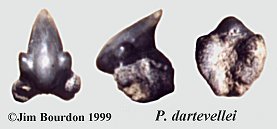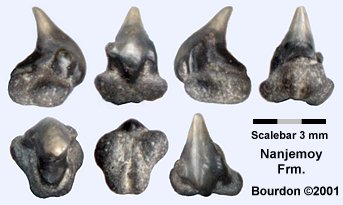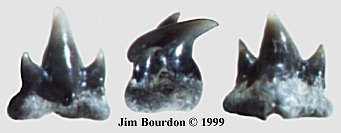| |
The largest living shark is Rhincodon typus
SMITH, 1829 - the extant whale shark. Represented
by a single species, this is a huge (12+ meter) suction filter-feeder which has a circumglobal
distribution in warm temperate and tropical waters. Teeth ascribed to Palaeorhincodon
have a similar distribution, having been reported from Eocene sediments of Europe, Africa,
North America and Asia. The extant genus/species feeds not only on plankton, but also small
crustaceans, fishes and squid. In the living species, the mouth is in a terminal position and
the dentition, homodont. Compagno (1984) reports that there are up to 300 files of teeth in each jaw.
The teeth of the extinct genus are small (the tooth in the below image is 3 mm in height), has a
lingually-directed cusp with lateral cusplets. The root is of typical orectolobid design -- when
viewed basally, the lobes form a "V", opening labially, with a central pore. Cappetta (1987) notes
there is a pair of margino-lingual foramina. Three species have been attributed to genus:
Palaeorhincodon daouii NOUBHANI & CAPPETTA, 1997 [Thanetian],
P. dartevellei (ARAMBOURG, 1952) [Ypresian] and
P. wardi HERMAN, 1974 [Lutetian].
 |
Fig. 1 - Palaeorhincodon dartevellei
hgt = 3.0, wid = 3.0, dep = 3.2 mm
Nanejemoy Formation, Virginia
From the Collection of Michael Folmer |
 |
Fig. 2 - Palaeorhincodon dartevellei
hgt = 4.0, wid = 3.0, dep = 3.0 mm
Nanejemoy Formation, Virginia
From the Collection of Daryl Serafin |
Some of the distinguishing characteristics of Palaeorhincodon daouii, as pointed out by
Noubhani & Cappetta, are that the teeth are slightly smaller and less laterally compressed,
bear well developed and divergent cusplets (sometimes two per side) and have a prominent but
not very broad apron.
 |
Fig. 3 - Palaeorhincodon daouii
hgt = 3.4, wid = 3.0, dep = 2.6 mm
Nanejemoy Formation, Virginia
From the Collection of Michael Folmer |
 |
Fig. 4 - Palaeorhincodon daouii
hgt = 2.5, wid = 2.8, dep = 2.0 mm
Nanejemoy Formation, Virginia
From the Collection of Michael Folmer |
|